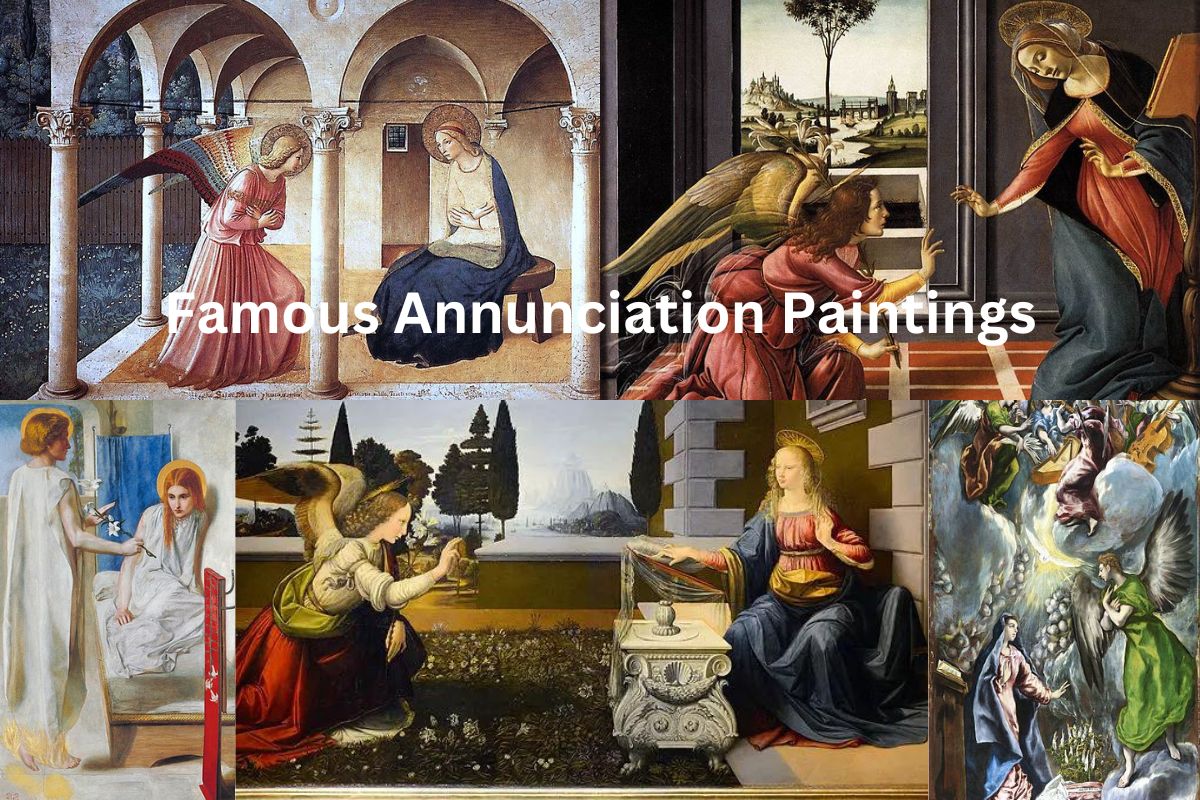The Annunciation is an important event in Christian theology that commemorates the time when the Archangel Gabriel informed the Virgin Mary that she had been selected to be Jesus’ mother.
Throughout history, this event has been a favorite topic for artists, and there are countless great Annunciation paintings from various times and styles.
Some of the most well-known Annunciation paintings include works by renowned artists such as:
- Leonardo da Vinci
- Sandro Botticelli
- Fra Angelico
- El Greco
- Jan van Eyck
- Caravaggio
- Titian
- William Holman Hunt.
These paintings represent the same subject, yet each artist’s perspective, style, and meaning are distinct. These masterpieces frequently contain startling compositions, complex details, and vibrant hues, making them some of history’s most recognized works of art.
These classic Annunciation paintings continue to attract spectators with their profound spiritual and artistic significance, whether presented in a conventional or contemporary form.
Famous Annunciation Paintings
1. Annunciation – Leonardo da Vinci
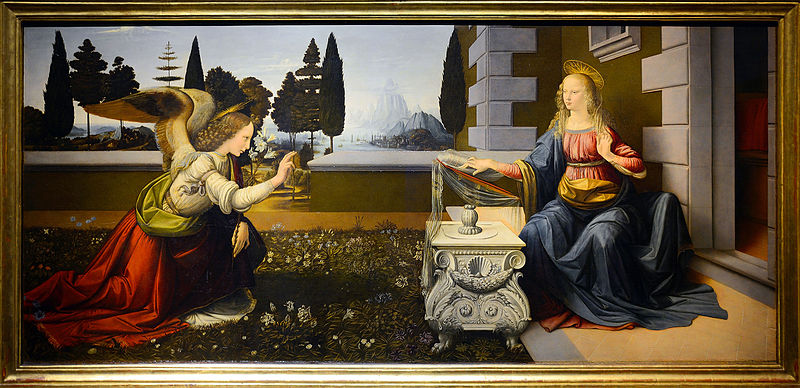
Leonardo da Vinci’s Annunciation is one of the most famous and celebrated Renaissance paintings. The artwork, which was completed between 1472 and 1475, represents the moment when the Archangel Gabriel informs the Virgin Mary that she has been selected to be the mother of Jesus.
Gabriel is depicted in the painting standing before Mary with his wings outstretched, while Mary is seated. The setting is an open loggia or portico with a distant countryside in the distance.
The marble table in front of Mary is most likely based on the tomb of Piero and Giovanni de’ Medici in Florence’s Cathedral of San Lorenzo, which Verrocchio sculpted around the same time period. The angel is holding a Madonna flower, which represents Mary’s virginity as well as the city of Florence.
It is assumed that Leonardo, a skilled observer of nature, painted the angel’s wings to resemble those of a bird in flight, but the wings were later substantially stretched by another artist.
The exquisite details, beautiful composition, and use of light and shadow to create a sense of depth and space distinguish this painting. The figures are represented with exquisite realism, and their expressions indicate astonishment and wonder at the extraordinary event that is taking place.
The Annunciation by Leonardo da Vinci is currently displayed in the Uffizi Museum in Florence, Italy, and is regarded as one of the greatest Renaissance works. Its ageless beauty and spiritual importance continue to inspire and attract onlookers.
2. Annunciation – Jan van Eyck
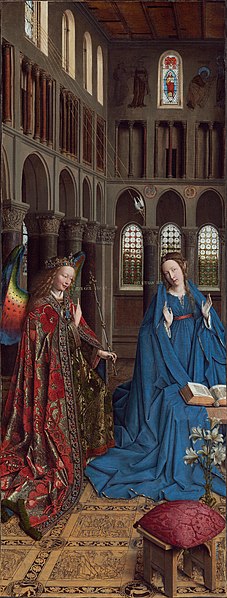
The Annunciation by Jan van Eyck is a well-known picture produced in 1434-1436 in Flanders during the Northern Renaissance period. The painting represents the moment the Archangel Gabriel informs the Virgin Mary that she has been selected to be Jesus’ mother.
Gabriel is depicted in the painting to the side of Mary, his wings stretched out behind him. He is holding a scepter, which indicates his authority, while his other hand is pointing to the heavens. Mary is depicted seated, her hands open in prayer and a book on her lap.
The setting is a Gothic-style room with a marble floor and finely sculpted architecture. In the background, there is a wooden bench, and a potted plant.
The artwork is renowned for its use of perspective and meticulous details, such as the reflections on the marble floor and the individual strands of hair on the heads of the people.
Jan van Eyck’s The Annunciation is currently located in the National Gallery of Art in Washington, D.C., and is regarded as one of the greatest masterpieces of Northern Renaissance art.
It is admired for its technical mastery, attention to detail, and spiritual depth, and is regarded as a notable example of the Northern Renaissance style’s realism and symbolism.
3. Cestello Annunciation – Sandro Botticelli
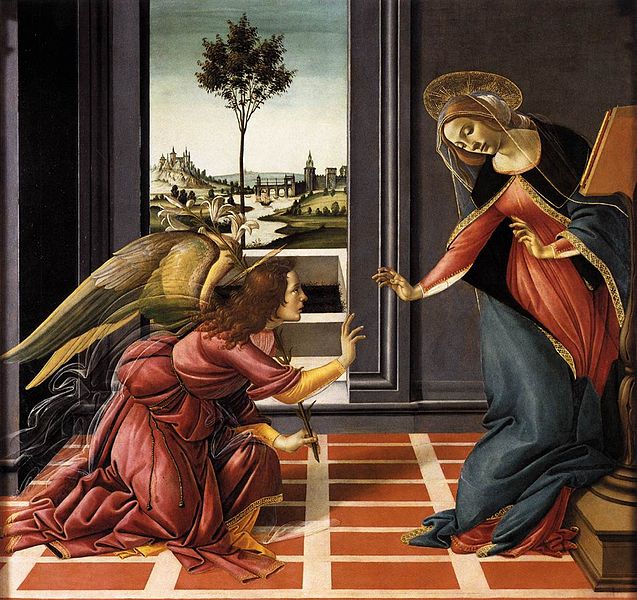
The Cestello Annunciation is a well-known artwork by Sandro Botticelli, an Italian Renaissance artist. During the High Renaissance period in Florence, Italy, the picture was finished between 1489-1490.
The painting represents the moment the Archangel Gabriel informs the Virgin Mary that she has been selected to be Jesus’ mother. Gabriel is depicted kneeling in front of Mary, his wings spread out behind him, holding a stem of lilies, a symbol of Mary’s purity.
Mary is seated on a chair, her head lowered in prayer and her hands out stretched. She is dressed in a blue robe and a scarlet cloak, both of which signify her purity and royalty. The painting’s background features a portico with a view of a garden, which represents the Garden of Eden.
The use of perspective, which provides a sense of depth and space, is one of the painting’s most remarkable features. Botticelli also employs light and shadow to create drama, with Gabriel’s figure casting a shadow on the floor.
The Cestello Annunciation is now on display at Florence’s Uffizi Museum. The artwork is regarded as one of Botticelli’s finest, owing to its superb composition, meticulous details, and deft use of symbolism.
4. Annunciation – Caravaggio
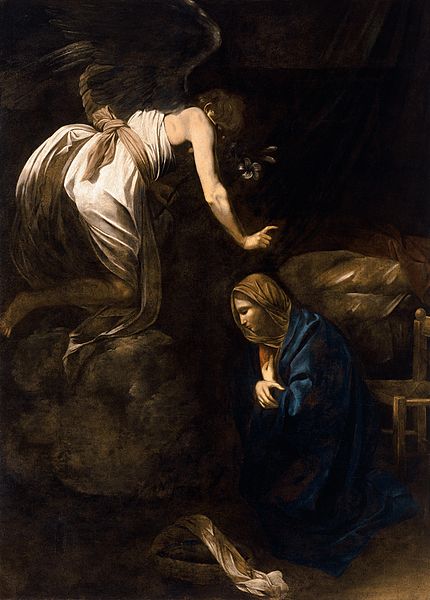
The Annunciation is an oil painting completed in 1608 by the Italian painter Michelangelo Merisi da Caravaggio. It was housed in the Nancy Museum of Fine Arts.
The picture has been severely damaged and restored, and only the angel, who resembles the figure in John the Baptist at the Fountain, has Caravaggio’s brushwork.
The angel’s illusionistic treatment, hovering on a cloud and appearing to protrude beyond the picture plane, is more Baroque than is typical for Caravaggio, but the contrast between the angel’s active position and Mary’s passive stance is dramatic and psychologically successful. The brushstrokes are characteristic of Caravaggio’s later phase.
Henry II, Duke of Lorraine, gave the painting to his primatial church in Nancy as the primary altarpiece; it was possibly obtained by one of the Duke’s sons on a 1608 journey to Malta.
The composition of the picture consists of two figures. Gabriel, the angel of the Annunciation, is believed to be the angel atop the Virgin Mary. Gabriel’s flowers are also a symbol of the Virgin Mary.
Gabriel informs the Virgin Mary of God’s plans for her as she is in a prostrate position. The artwork features Caravaggio’s distinctive sfumato and tenebrism, with the exception of the two major figures, virtually the entire canvas being gloomy.
5. Ecce Ancilla Domini! – Dante Gabriel Rossetti
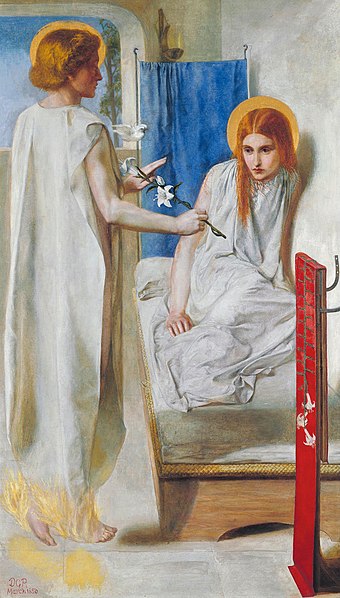
Ecce Ancilla Domini (Latin for “Behold the handmaiden of the Lord”), often known as The Annunciation, is an oil painting by English artist Dante Gabriel Rossetti that was completed in 1850 and is presently housed in the Tate Britain in London.
The Latin title is a passage from the Vulgate text of Saint Luke’s first chapter, which describes the Annunciation, in which Mary receives the message sent to her by the Angel Gabriel that she will bear a child (Jesus) by God.
The title should be Ecce Ancilla Domini!, although several sources leave off the exclamation mark.
Rossetti’s The Girlhood of Mary Virgin (1849), Tate Britain.
Rossetti purposefully selected a limited color palette in this oil painting.
The preponderance of white, symbolic of virginity, is balanced by bright blue (a color connected with Mary, but not used in his 1849 novel The Girlhood of Mary Virgin) and red, representing Christ’s blood.
In Italian Renaissance art, lilies are typically a sign of Mary, but they are also regarded funereal flowers, representing Christ’s death.
Ecce Ancilla Domini is considered a classic of the Pre-Raphaelite movement and one of Rossetti’s most significant works.
The painting’s complex intricacies and vibrant colors show the Pre-Raphaelites’ aim to reject the artificiality and superficiality of Victorian art and return to earlier periods’ simplicity and sincerity.
6. The Annunciation, with Saint Emidius – Carlo Crivelli
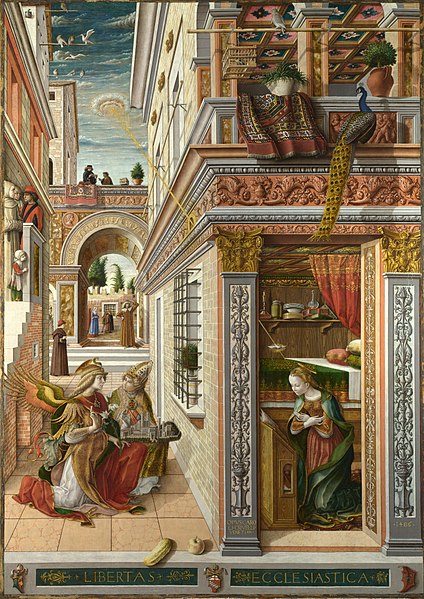
Carlo Crivelli’s altarpiece The Annunciation with Saint Emidius depicts an artistic version of the Annunciation.
It was created for the Church of SS. Annunziata in the Italian town of Ascoli Piceno, in the Marche region, to commemorate the town’s self-government granted by Pope Sixtus IV in 1482.
The artwork was transported to the Pinacoteca di Brera in Milan in 1811, but it was purchased by Auguste-Louis de Sivry in 1820 and had arrived in England by the mid-nineteenth century. It has been housed in the National Gallery in London since Henry Labouchere, 1st Baron Taunton donated it in 1864.
The light ray from the sky signifies the Holy Spirit bringing Jesus Christ into Mary’s womb. Mary’s virginity is traditionally represented by the closed doorway into the abyss on the left and the flask of pure water in her bedroom.
Gabriel, the winged angel, is pictured with Saint Emidius, the patron saint of Ascoli Piceno, holding a model of the town. The foreground apple signifies the forbidden fruit and the related fall of man. The cucumber represents the possibility of rebirth and redemption.
Because its flesh was thought to never decompose, the peacock was associated with immortality. The loggia on the first floor of Mary’s residence is adorned with an oriental carpet.
The coats of arms of Pope Sixtus IV and the local bishop, Prospero Caffarelli, are seen at the bottom of the painting. The Latin terms libertas ecclesiastica (church liberty) refer to Ascoli Piceno’s self-government under the general supervision of the Catholic Church.
7. Annunciation – Filippo Lippi
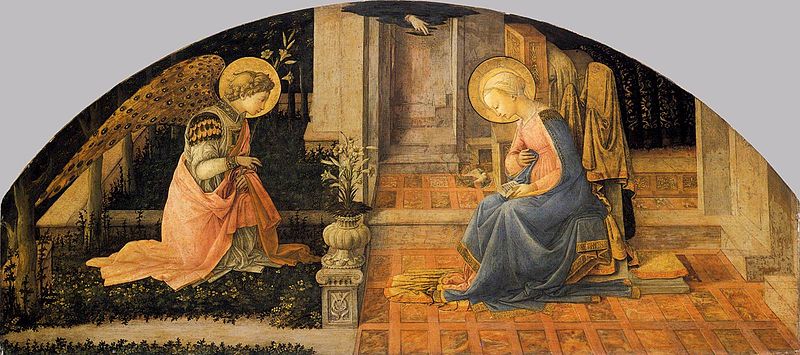
The Annunciation is a tempera on panel painting by the Italian Renaissance master Filippo Lippi that dates from around 1449-1459 and is housed in the National Gallery in London.
It is a companion piece to Lippi’s Seven Saints, which is currently on display at the National Gallery. The lunettes were commissioned for the Palace Medici in Florence, where they were most likely positioned above a door or a bed.
Lippi’s authorship of the panels is widely accepted, but their chronology is less definite; they were created between Lorenzo the Magnificent’s birth in 1449 and the completion of the palace’s outfitting in 1459.
The presence of Piero di Cosimo de’ Medici’s coat of arms (three feathers crossed by a ring with diamond and cartouche) at the base of the tiny column with a vase that splits the painting in two confirms that their patron belonged to the Medici family.
The Annunciation of Mary is depicted in the painting, with the archangel Gabriel (left) and Mary (right). God, whose hand can be seen at the top of the lunette, is blessing Mary through the dove, which represents the Holy Spirit.
Sir Charles Eastlake purchased both lunettes from the Metzger Brothers in 1855 and donated them to the National Gallery in 1861.
8. Annunciation – Titian
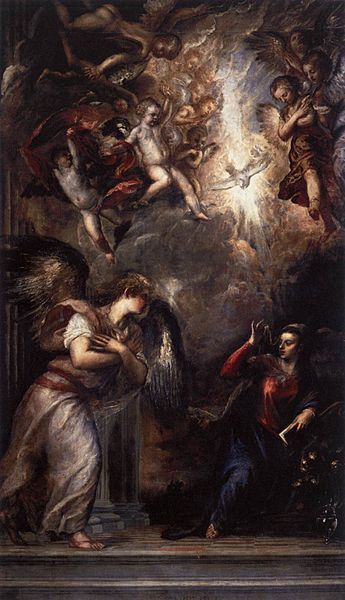
The Annunciation is a painting by Titian, an Italian Renaissance master who worked between 1559 and 1564. It is still housed in Venice’s San Salvador church, for which it was commissioned.
The D’Anna family commissioned three paintings for their chapels at the church of San Salvador in Venice, northern Italy.
Only two of the three are still present in the church. Other commissions included a Transfiguration from around 1560, which served as the high altar’s altarpiece, and a Crucifixion, which is now housed in the Church of San Domenico in Ancona.
The picture represents the Annunciation of the Virgin, which occurs when the Virgin Mary is informed that she is carrying God’s child.
The lower figures are Mary (Jesus’ mother) and Gabriel. Mary is represented in a state of shock, but Titian’s use of color highlights the appearance of the angel. This is especially noticeable in his use of light. A divine light streams from an aperture in the sky into the Annunciation site.
9. The Annunciation – El Greco
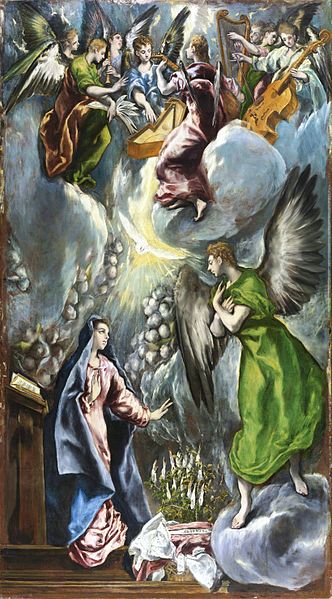
The picture was the focal feature of the altarpiece in Toledo’s Santo Domingo el Antiguo church. El Greco created nine pieces for this church, the first of which was this altarpiece.
El Greco began his 37-year career at Toledo, where he painted The Assumption of the Madonna in a realistic manner with massive figures and a Roman school palette, inspired by Michelangelo.
El Greco’s composition for his Assumption of the Virgin is quite similar to Titian’s Assumption at Venice’s Basilica dei Frari, with the Virgin Mary and angels in the upper portion of the painting and the apostles in the lower part.
The Virgin Mary is seen floating upward, a symbol of her sanctity, while the apostles gather around her empty tomb, shocked and concerned.
10. Annunciation – Fra Angelico
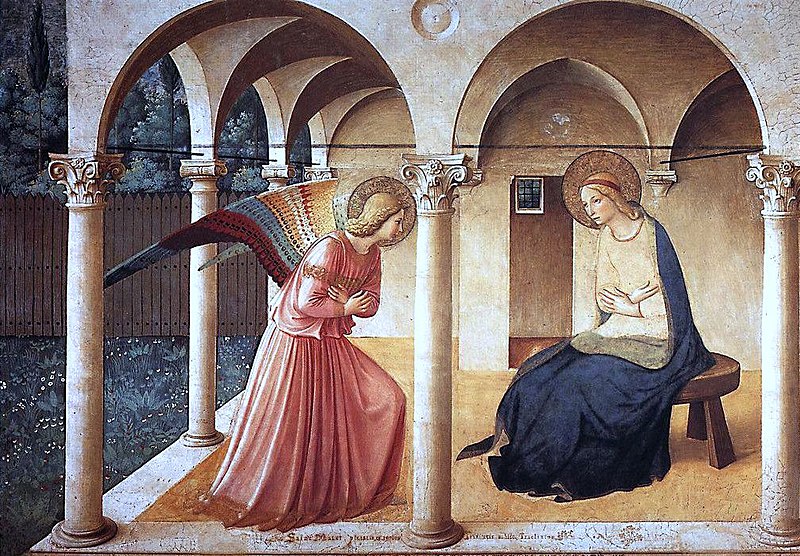
Fra Angelico’s The Annunciation is an early fresco painting that deserves to be included on our list.
According to art historians and researchers, this artwork was made between 1440 and 1445. Fra Angelico was a lesser-known Renaissance artist, yet many of the most famous painters were inspired by his methods and techniques.
This particular work was completed at the Monastery of San Marco in Florence, Italy, and it is still considered to be one of the best-preserved fresco paintings to this day.
The picture depicts the moment when the angel Gabriel appears to Mary and tells her that she would soon be carrying the child who will become the Messiah.
There are several additional depictions of this Bible story, but only a few show both characters outside.
11. The Annunciation – John William Waterhouse
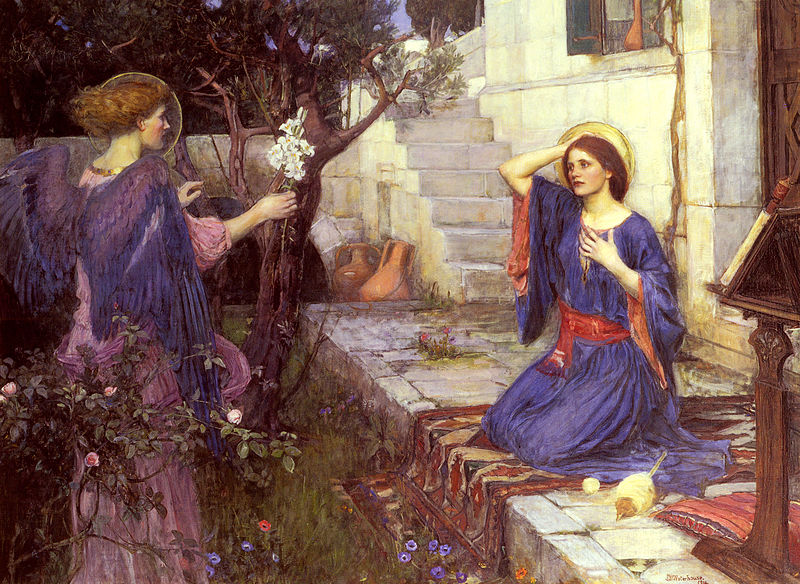
Most people recognize John William Waterhouse as the painter of the iconic “The Lady of Shalott” (1888).
He was a latecomer to the Pre-Raphaelite movement, having been born in Rome in 1849, around the time the three artists created the Pre-Raphaelite Brotherhood.
John William Waterhouse’s portrayal of the Annunciation in a garden filled with lush carpets and ceramic pots reflects his interest in Greek mythology and Arthurian romance. This work is in a private collection.
12. The Annunciation Triptych– Rogier van der Weyden
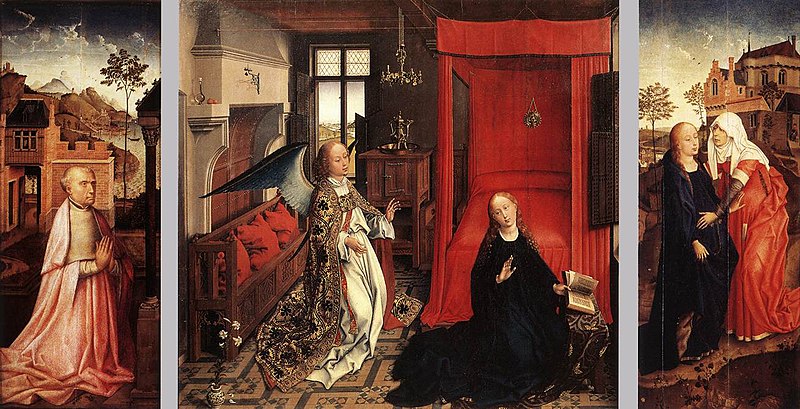
The Annunciation Triptych is a 1434 oil-on-panel triptych by the Netherlandish artist Rogier van der Weyden.
It was originally composed of three panels, the center one of which is now housed in the Louvre museum in Paris, France, and the side panels in Turin, northern Italy.
It is an early work by the Dutch artist, with re-elaborations of pieces by Robert Campin and Jan van Eyck apparent. The middle panel shows a composition within a household atmosphere, with a beautifully dressed Angel surprising a Virgin reading a book (a symbol of the Holy Books).
Van der Weyden devoted close attention to technical elements, such as the gleaming metallic objects, such as the lamp, jar, and medallion hanging above the bed. The horizon line is raised, as in other modern Dutch paintings.
The side panels have similar features, but are set in more bright landscapes, with the components in the backdrop becoming progressively invisible in the haze as the viewpoint shifts to aerial.
13. Annunciation with St. Margaret and St. Ansanus – Lippo Memmi and Simone Martini
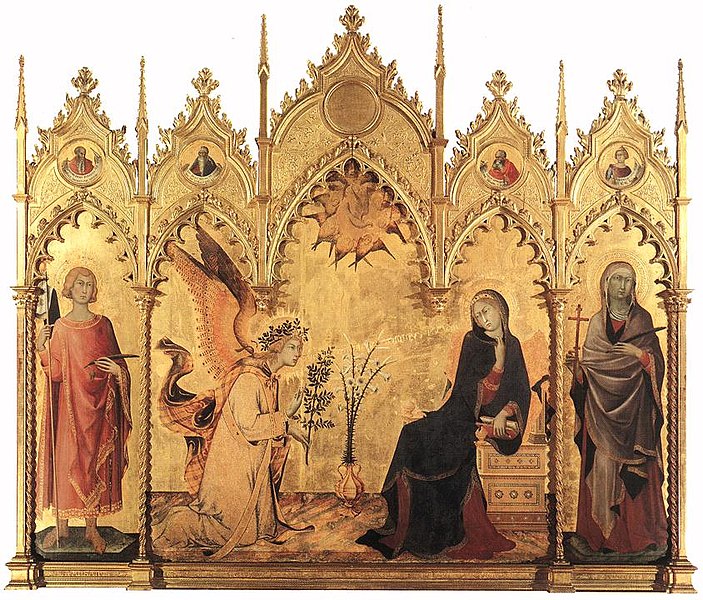
The Annunciation with Saint. Margaret and St. Ansanus is a painting by Italian Gothic artists Simone Martini and Lippo Memmi that is now located in Florence, Italy’s Uffizi Gallery.
It is a hardwood triptych painted in tempera and gold, with a double-sized middle panel. The piece was initially created for a side altar in the Siena Cathedral and is considered Martini’s masterwork and one of the most spectacular works of Gothic painting.
The composition of the work includes a massive central panel representing the Annunciation, two side panels with St. Ansanus (left) and a female saint, often associated with St. Maxima or St. Margaret, in the right, and four tondos in the cusps: Jeremiah, Ezechiel, Isiah, and Daniel.
The Annunciation depicts the archangel Gabriel entering the house of the Virgin Mary to inform her that the child Jesus, whose name means “savior,” will be born shortly. Gabriel holds an olive branch, a traditional symbol of peace, in one hand while pointing to the Holy Spirit’s dove with the other.
The dove is going to enter the Virgin’s right ear as it descends from heaven, from the middle of the mandorla of eight angels above. Along the path of the dove, viewers can hear Gabriel say: ave gratia plena dominvs tecvm (“Hail, full of grace, the Lord is with thee.”). A beautiful “tartar fabric” pattern and delicate gold feathers adorn the angel’s mantle.
Mary, seated on a throne, is depicted as she is jolted out of her reading, reacting with a graceful and controlled reluctance, gazing surprised at the celestial messenger. Her gown has an arabesque pattern.
The two patron saints of the church are separated from the primary image by two decorated twisting columns on the sides. The background is entirely gold and features a vase of lilies, an allegory of purity frequently connected with the Virgin Mary.
The employment of a Gothic line, as well as realistic components such as the book, vase, throne, and pavement in perspective, as well as the realistic activity of the two characters and their delicate nuances of character, represent a significant departure from the bi-dimensionality typical of Byzantine painting.

